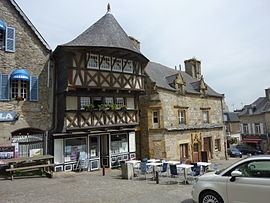Country France Canton Saint-Renan Area 13.31 km² | Intercommunality Pays d'Iroise Local time Wednesday 2:10 AM | |
 | ||
Weather 11°C, Wind S at 32 km/h, 92% Humidity | ||
Saint-Renan (Breton: Lokournan) is a commune in the Finistère department of Brittany in north-western France.
Contents
- Map of 29290 Saint Renan France
- History
- Population
- Tourism
- Breton language
- Notable natives and residents
- References
Map of 29290 Saint-Renan, France
History
The city is named after the Irish saint "Ronan", who came in the Vth century to evangelize the area.
While Brest was a village, the city of Saint-Renan will develop throughout the Middle age. In 1276, the Duke of Brittany even established one of the court of justice there. Until the end of the XVIIth century, Saint-Renan is a big "Sénéchaussée" (the town of the seneschal) first ducal and then royal. It had a central place in the everyday life on inhabitants. A lot of buildings in the center town are from this period.[1]
Population
Inhabitants of Saint-Renan are called Renanais in French.
Tourism
Old houses of XVth and XVIth centuries are historical and architectural attractions.
Every two years, the medieval festival of Saint-Renan, the biggest of the department, highlights the city's heritage. The 15th edition will take place on the 15th and 16 July 2017. [2]
The saturday morning market - one of the biggest - is the opportunity to taste local products such as "kouign amann" (cake which name means "sugar and butter" in Breton language), Kig Ha Farz, algae, crepes, cider, caramel, chitterlings sausages...
The six artificial lakes are part of the industrial heritage of the city, which nickname was "the European capital of pewter" in the 60s. The two largest ones, named "Ty Colo" and "Comiren" are perfect places for long relaxing walks.
The church of the XVIIth century has undergone several transformations over time. Built on top of a hill, its bell tower is visible from a large part of the city. The churchyard contains a military area dedicated to the British aviators from the Royal Air Force who died for freedom and for France during the World War II.[3]
Breton language
In 2016, 14% of primary-school children attended bilingual schools.
